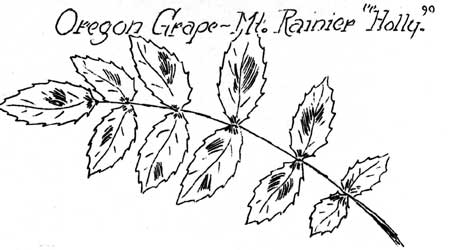OREGON GRAPE - MT. RAINIER "HOLLY".

True holly is not native to Mount Rainier National Park but we have
an adequate substitute in the Oregon Grape which is found growing
profusely throughout the lower regions of the Mountain - particularly in
the dense forests. Here it contributes to the tangled mass of
vegetation that is characteristic of Mt. Rainier's timbered regions and
its shiny, green, holly-like leaves are often mistaken for true holly at
first glance.
It is in no way related to the holly however, being a member of the
Barberry family and in that respect being a relative of the outlawed
barberry of many wheat growing states - a plant that aids in the
disemmination of the wheat rust that destroys much of this valuable crop
each year. The Oregon Grape rarely occurs near wheat and is
consequently not regarded as a dangerous, destructive agent of that
grain. Here in the park it is a pretty little shrub and in some sities
of the Northwest its beauty adds to the landscape plans of many homes.
Why is it called a "grape"? From its grape-like fruit one can make jam
- provided enough of those "grapes" can be found to make the trouble
worth while.
IRON PYRITES - FOOL'S GOLD!

Iron Pyrites justly deserve the name of "Fool's Gold" for outwardly
it bears a striking resemblance to that valuable mineral. It owes it's
rich color to the sulphur which composes over 50% of the mineral and
obviously has no connection with gold which it so closely resembles.
Ranger Harold Hall of the White River District sent over several
large blocks of granite, taken from the Yakima Park road excavation,
which embodied quite a lot of this "rich looking ore" and it is safe to
say that it will cause no little comment on the part of visitors to the
Park Museum. Because of its high sulphur content Iron Pyrites is used
in the manufacture of sulphuric acid.

